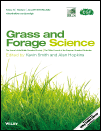Ver ítem
- xmlui.general.dspace_homeCentros Regionales y EEAsCentro Regional Buenos Aires SurEEA Hilario AscasubiArtículos científicosxmlui.ArtifactBrowser.ItemViewer.trail
- Inicio
- Centros Regionales y EEAs
- Centro Regional Buenos Aires Sur
- EEA Hilario Ascasubi
- Artículos científicos
- Ver ítem
Self‐regeneration of hairy vetch (Vicia villosa Roth) as affected by seedling density and soil tillage method in a semi‐arid agroecosystem
Resumen
Vicia villosa Roth is a forage legume with the capability for biological N fixation and natural reseeding, which could contribute to sustainability in semi‐arid regions. This study aimed to determine (i) the relationship between vetch density, seed production and spontaneous seed dispersal; (ii) the impact of the post‐dispersal tillage treatment over the soil seedbank dynamics; and (iii) potential predation of the seedbank by feral pigeons. A density
[ver mas...]
Vicia villosa Roth is a forage legume with the capability for biological N fixation and natural reseeding, which could contribute to sustainability in semi‐arid regions. This study aimed to determine (i) the relationship between vetch density, seed production and spontaneous seed dispersal; (ii) the impact of the post‐dispersal tillage treatment over the soil seedbank dynamics; and (iii) potential predation of the seedbank by feral pigeons. A density range between 50 and 200 plants m−2 did not influence seed production or seed dispersal. Shallow disc tillage (SDT) clearly favoured self‐regeneration, resulting in higher amount of emerged seedlings during autumn compared to no tillage (NT). Based on observed emergence data, the percentage of emerged seedlings under SDT and NT were 38 and 6% of the seedbank, respectively, during 18 months after plot harvest. The lowest emergence values registered under NT could be associated with higher pressure from natural predators, soil‐borne pathogens, seed decay by ageing and false breaks. The feral pigeon (Columba livia var.) might be considered the main cause of vetch seedbank depletion in this study. Under controlled conditions, a single pigeon is able to consume, on average, between 184 and 768 seeds per day, depending on seed exposure and alternative food sources availability.
[Cerrar]

Autor
Renzi Pugni, Juan Pablo;
Chantre Balacca, Guillermo Ruben;
Cantamutto, Miguel Angel;
Fuente
Grass and forage science 72 (3) : 524-533. (September 2017)
Fecha
2017-09
ISSN
0142-5242
1365-2494
1365-2494
Formato
pdf
Tipo de documento
artículo
Palabras Claves
Derechos de acceso
Restringido
 Excepto donde se diga explicitamente, este item se publica bajo la siguiente descripción: Creative Commons Attribution-NonCommercial-ShareAlike 2.5 Unported (CC BY-NC-SA 2.5)
Excepto donde se diga explicitamente, este item se publica bajo la siguiente descripción: Creative Commons Attribution-NonCommercial-ShareAlike 2.5 Unported (CC BY-NC-SA 2.5)

